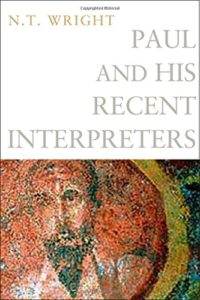Paul and His Recent Interpreters, by N. T. Wright (Fortress Press, 2015), 414 pages.
In 1911, Albert Schweitzer wrote Paul and His Interpreters, which not only summarized the history of Pauline interpretation but also located Paul within Judaism. In the last century there has been a stream of different approaches to Paul, from classical liberalism, to a history of religions approach, to existentialism, to a redemptive-historical approach, to the New Perspective, and finally today we have apocalypticism.
Earle Ellis updated Schweitzer’s work to 1964 when he published Paul and His Recent Interpreters. His work situated Paul, along with Schweitzer, in a Jewish matrix, but also in a way that sat comfortably within the redemptive-historical school. Many other histories of Pauline research have been written, but these two have stood as fine landmarks, 50 years apart.
And now, another half century later, N. T. Wright has picked up the mantle to summarize recent trends in Pauline research. His Paul and His Recent Interpreters looks much different than Schweitzer’s or Ellis’s work because he is taking a detailed look at the most prevalent issues today. In most topics he tries to the origin of the debate to the most influential scholars who set the tone or started the discussion.
Summary
In the first chapter, “Setting the Stage,” he surveys from Baur on and the issue of Paul’s Jewish or Gentile origin, questions hashed out in times past. He then looks in chapter 2 at the various theological questions that scholars have supposed Paul to be asking. He deals here mostly with those from the 50’s to the 70’s, such as the Bultmann vs. Cullmann controversies.
This leads of course to the 70’s and Sander’s bomb, Paul and Palestinian Judaism. His thoughts about Sanders’ view of second-temple Judaism and of Paul’s thought is no surprise, since he has lodged his objections many times elsewhere, including his New Testament and the People of God. He then discusses the variegation of New Perspective advocates and responds to criticisms of those from the Old Perspective. His dismissal of much of that criticism, especially by Westerholm, is unfortunate, since it generally consists of broad strokes rather than detailed exegesis of the passages OP scholars like Westerholm often use to demonstrate problems with the New Perspective.
Part II of the book examines apocalyptic, discussing what it is (the genre and definition problem), the contributions of Kasemann and Beker, followed by the landmark and influential works of de Boer and Martyn, and finally his (not so flattering) take on Campbell’s work.
Part III looks at Paul’s social world, an area of research that has flourished since Wayne Meek’s The First Urban Christians. Wright examines the social history of Pauline communities, foundations works by Meeks and Horrell, and Paul in the marketplace.
Evaluation
Wright’s work is useful in many ways and predictable in others. Wright’s characteristic flair for the big picture helps him flourish in weaving through the various scholars and the minutiae of their positions. Throughout, he introduces little historical facts about the background of scholars (such as Beker’s suffering at the hands of the Nazis) that help make more sense of that scholar’s work. One must be careful, though, not to rely too heavily on such background information, lest one seek to “explain” someone’s work the way Bultmann incessantly needed to “explain” Paul.
His selection of topics is appropriate. Although we are “post-New Perspective,” the history of the topic is still relevant, and apocalypticism is perhaps the most contentious American issue. Students would do well to read these sections to get a grasp on these two issues to be able to sift through current literature on Paul.
Predictably, Wright sweeps through most criticisms of his work and also tells the history in a way that leads climactically to his positions. Wright would acknowledge that history is generally told this way, so it is not so much a criticism of the book as much as a warning for those reading it. Unfortunately, Wright must keep the volume to American scholarship in the 70’s and beyond, which he laments as he should. The book would have become too large if Wright included German discussions, but what the most important discussions are would have been helpfully included in the book if he had briefly summarized them in the introduction.
Lastly, I should note that Wright intends this as a companion volume for his Paul and the Faithfulness of God. (Although, once you’re at 1,700 pages, why not just add another 450 page history of research section?) I therefore recommend this book for anyone studying recent issues in Pauline theology, for pastors wanting to understand these trends, and for anyone who plans to read Paul and the Faithfulness of God.
Preview or buy it here on Amazon.



